Coastal communities up and down the country are changing shape with Covid speeding up people’s decisions to either move to the beach or buy a holiday home to escape to.
The virus has led to shifting patterns of residency with agents reporting instead of the traditional heading off to the bach from town on a Friday night there’s a growing trend of people opting to live at the bach and commute to the office.
Analysis of New Zealand’s bach market by OneRoof and its data partner Valocity found an explosion in second home purchases in coastal locations in the months after the first Covid lockdown, with Kiwis spending $14 billion on coastal property since June 2020.
The analysis also found a huge lift in beach town property values, with house prices in some of the more popular locations rising by more than $500,000 post Covid.
Start your property search
OneRoof and Valocity examined sales activity and value movement in 251 beach and costal locations around New Zealand. The analysis covered non-urban centres with more than 100 residential properties within 800 metres of the coast line. Beach suburbs such as Mount Maunganui and Papamoa were not included because they are located in big urban centres, but Auckland fringe locations such as Omaha and Waiuku were.
The key findings include:
- A surge in sales: The total number of sales in the 251 locations covered over the five-year period analysed was 35,356. Of those, 45% (15,997) were "second home" purchases – that is, purchases that took the owner into the multi-homeowner category.
Overall sales plunged at the start of the Covid crisis to 76 but then exploded following the lifting of the lockdown restrictions, with the monthly average for the second half of 2020 rising to just over 760 and the share of second home purchases rising above 50%. Sales declined in the first half of 2021 as tighter lending laws made second purchases harder but there was a brief resurgence in the market towards the end of the year. Sales volumes now, however, are below 2017-2019 levels with rising interest rates likely a key factor in the overall market slump.
- Lower value spots and Auckland's fringe extremely popular with buyers: The locations with the highest share of dwellings owned by multi-homeowners are: Te Araroa, Gisborne (83%); Taharoa, in Waikato (82%); Tokomaru Bay, Gisborne (78%); Okura Bush, Auckland (74%); and Te Kaha, Bay of Plenty (73%).
Twelve locations scattered around the fringes of Auckland's urban centres have more than 50% of dwellings owned by multi-homeowners, which suggests Aucklanders still like to be within driving distance of their baches.
- The most expensive baches can command $7m-plus: The median purchase price of a second home in Q1 of this year was $1m or more in 79 locations, and $2m or more in nine. The locations with the highest median purchase price in Q1 were: Okura, Auckland ($5,300,000); Omaha, Auckland ($4,395,000); Tata Beach, Tasman ($3,450,000); Sandspit, Auckland ($3,388,000); and Oneroa, Waiheke Island ($2,460,000).
The analysis also identified 13 property purchases for more than $7m, mostly in Omaha and Waiheke Island - the highest purchase price over the two-year period in the locations covered was $10.25m for a home in Oneroa.
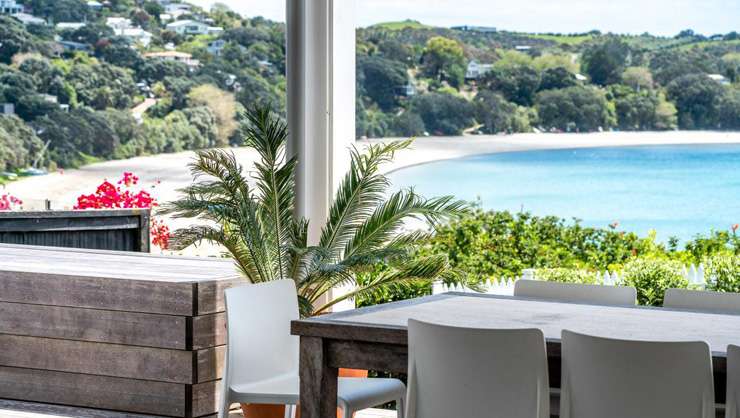
The view from a bach on Waiheke Island that sold last year for more than $10m. Photo / Supplied
- West Coast the cheapest place to buy a bach: Twenty locations had a median purchase price of less than $500,000 for a second home in Q1 2022, with the West Coast accounting for the lion's share. The cheapest “second” purchases were in: Waipapakauri, Northland ($130,000); Cobden, West Coast ($191,000); Patea, Taranaki ($260,000); Blaketown, West Coast ($275,000); and Gladstone, West Coast ($295,000).
The analysis also looked at how much property values had changed, both in dollar and percentage terms, in each of the locations in the two years to the end of September to gauge how popular an area was with buyers. The timeframe was chosen because it covered the post-Covid property boom and the closure of international borders, anecdotally key driving factors of the second home market. Of the 251 locations analysed, 30 enjoyed value growth of more than 50% in the two-year period, and five, mostly in fringe coastal spots in Dunedin, registered growth of less than 20%.
In 26 locations the average property value jumped more than $500,000 in the two-year period while in 12 locations growth was less than $100,000. The five locations with the biggest price jumps were: Waiheke Island, Auckland (up $1,011,000 to $3,622,000); Tawharanui Peninsula, Auckland (up $920,000 to $2,659,000); Whitford, Auckland (up $893,000 to $3,633,000); Omaha, Auckland (up $761,000 to $2,724,000); and Oneroa, Waiheke Island (up $673,000 to $2,349,000).
Overall, those who bought a second home in the closing months of 2020 got the best bach bargains.
James Wilson, head of valuations at Valocity, says the data and analysis shows just how hot many of NZ’s coastal markets were after the initial Covid lockdown.
“Many homeowners were able to utilise equity from their main home to leverage the purchase of a second home/holiday home. A low interest rate environment also helped fuel demand," he says.

Valocity head of valuations James Wilson: "“The ‘sea change’ was not just a Kiwi thing." Photo / Fiona Goodall
Wilson adds: “The 'sea change' was not just a Kiwi thing; this phenomenon was also observed internationally as the desire to live and work from coastal locations grew, supported by increasing work from home flexibility offered by many employers.
“Interestingly, whilst sales activity has slowed significantly in many coastal locations, we are not seeing signs of significant downward pressure on value levels, headwinds are not yet strong enough to push them down.
“Anecdotally, we are hearing of increased interest levels during early spring, and we will be watching closely to see whether this interest correlates to stronger value levels as we move towards summer months.”
Lockdown effect
Agents spoken to by OneRoof repeatedly talked of people taking stock of their lives over the last couple of years and taking advantage of the new work from home freedoms, setting up an office at the bach.
A consequence has been standards lifted in what were once purely holiday homes – older style Kiwiana baches made of patched-together corrugated iron painted bright colours are hard to find these days.
Other big buyers of holiday homes have been older people who hated being locked down away from their families so much they sold up and bought a place at the beach within easy reach of children and grandchildren.
Even grandparents living in idyllic holiday spots like the Bay of Islands have moved to coastal locations further south to be near family, determined not to repeat the isolation they felt during lockdowns.
Agents also report the big demand they have seen over the last few years at some holiday spots has meant buying at the beach is not necessarily a cheaper option anymore.
Just to buy a basic two or three-bedroom holiday home back from the beach has hit the $1m-plus mark in places like Cooks Beach on the Coromandel Peninsula and that won’t have sea views. Beachfront there, as in many coastal locations, is now instantly in the millions.
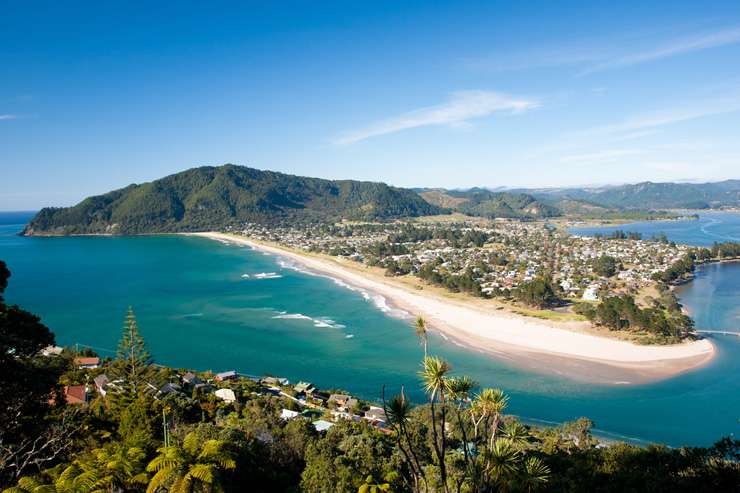
Popular with holiday home-buyers, especially Aucklanders, is Pauanui, in the Coromandel. Photo / Getty Images
For most people, being able to drive to their holiday home within a couple of hours is still a big must. For Cantabrians that might be Akaroa; for Aucklanders it’s traditionally been the Coromandel Peninsula or north of the city to places like Omaha and Mangawhai.
With Omaha becoming the domain of the uber-wealthy (beachfront there can cost $7m-plus), Aucklanders have pushed further north to Mangawhai which in turn has morphed from purely a holiday spot to a bustling town with subdivisions and employment.
A result has been people searching further up the coast in locations like Waipu and Ruakaka in Bream Bay – and Ruakaka is booming, says Joanne Dews, of Bream Bay Realty.
She thinks the once sleepy beach community is probably the fastest-growing coastal location north of Auckland. “People have been buying up baches left, right and centre. We have waiting lists for people that are looking for the right property for them.”
The settlement, which boasts both a surf beach and an inner harbour beach, is about 130km north of Auckland and 30km south of Whangarei.
Long waiting list
Dewson says while Aucklanders are the biggest buyers, she’s also seen people coming down from the Bay of Islands and up and across from Waiheke Island.
People from further north like to be closer to Auckland and its amenities, and people from Waiheke like the nostalgic vibe.
“They feel Waiheke’s outgrown them. It’s got so very busy and (Ruakaka) reminds them of Waiheke funnily enough.”
Dewson has also seen an increase in older people who weren’t able to go on cruises or travel overseas putting their money into beach properties so the whole family can come together. “They are thinking about not much point in having the money in the bank because it’s not earning any interest.”
She thinks Ruakaka has overtaken the Coromandel in popularity for Aucklanders, saying traffic-wise it’s easier to get to, and she says people who can no longer afford to buy in Mangawhai can probably afford Ruakaka.
Mangawhai is an example of a holiday destination which has turned into a lifestyle destination, says Stephen Owles, from Bayleys Mangawhai. “We’ve learned a lot over the last two years of how to work remotely so our influx of population and the way the region is developing is going to continue for the next two to five years at least.”
Mangawhai has become pricey, though. A 400-500sqm section without views is around half a million dollars. The price doubles for a view and to buy right on the water, or one back from the beach, now costs $2m to $3.5m, a lot of money for a holiday home.
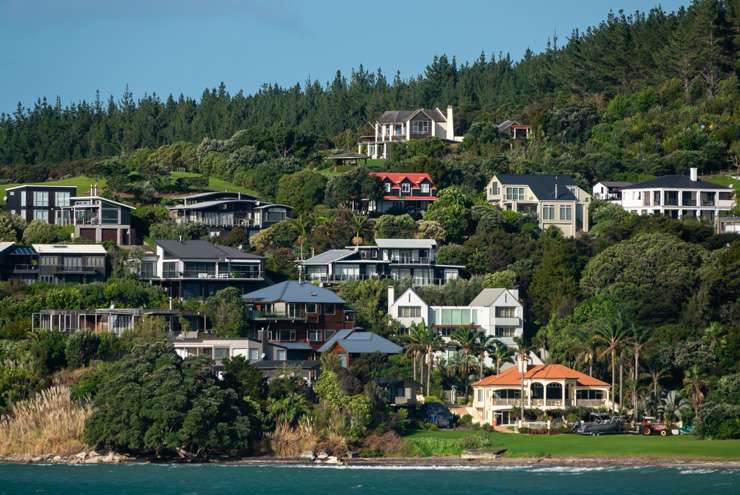
Langs Beach, in Whangarei, is home to some of Northland's most expensive and desirable coastal properties. Photo / Getty Images
Over the hill from Mangawhai is coveted Langs Beach, which has few facilities but big, quality multi-million dollar homes. Owles says there’s a long waiting list to get into Langs Beach so while few properties come to market when they do they sell quickly.
Aucklanders after a holiday home also headed to the Coromandel in droves after Covid arrived. Chris Speedy, of Whangamata Real Estate, says the market in the surf town was hectic after Covid arrived.
“We found a lot of people, Aucklanders especially, were sick of the lockdown and wanted to get out of there.”
The general consensus was if people had to be locked up they would rather be locked up at the seaside: “That was a motivator for some to get a holiday home.”
Lockdown effect
Speedy has noticed new trends, saying people are still transitioning out of the cities. Some are buying holiday homes as permanent homes by perhaps downsizing or selling up their Auckland property. “They got a practice start at working remotely over Covid,” he says.
“There’s quite a lot of people that will shoot up (to Auckland) for two days a week or just shoot up for a meeting and if you time your run you’re only a couple of hours away.”
Other people have a plan, Speedy says: “They are starting the move now and buying something they can go ‘right, we can either do this up or they’ve got a 2, 3, 4, 5-year plan to transition here permanently.”
People who have sold up in Auckland are not regretting their decision, either, Speedy says. “It’s more once they get here they go ‘why didn’t I do it sooner?’.”
People from the Waikato and Bay of Plenty, including farmers, also like to buy in Whangamata.
Further up the Coromandel Peninsula, Cooks Beach has also seen an increase in permanent residents who work remotely. “There’s definitely been a mindshift I think, or a reset,” says Merv Gardiner, branch manager of Richardsons Cooks Beach.
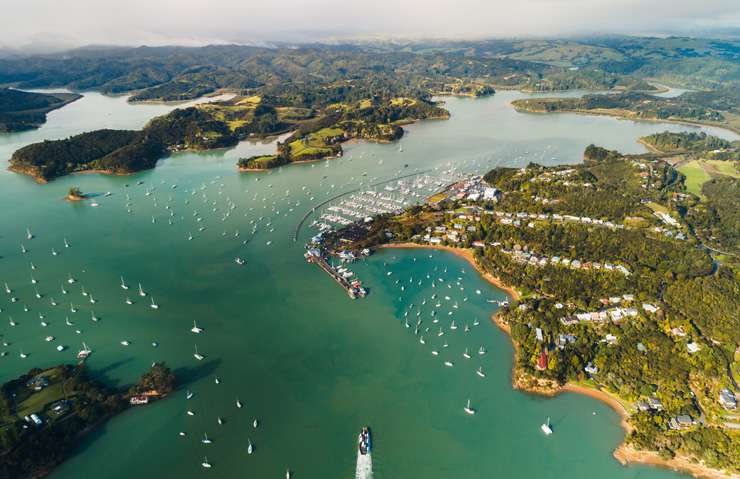
Bay of Islands, in Northland, is a playground for the super-rich in New Zealand. Photos / Getty Images
“We’ve definitely got more people wanting to buy a beach house especially at entry level, which now in Cooks is above $1m, which used to be probably half that three years ago.
“It’s not a cheaper option now than Auckland, as such, but it seems to be a mindset option I think.”
Cooks Beach has limited stock, however, so again there is a waiting list to get in and Gardiner says that’s especially at the entry level. “Just recently we sold a place, two-bedroom older bach. It was tidy, good section but no water views or anything, sleepout down the back, and that sold for $1.2m – you wouldn’t have dreamt of that price a few years ago.”
A lot of the holiday homes in Cooks Beach are still empty half the year but those who do live there permanently often rent them out in peak times where they might fetch $400 a night. “Friends of mine built themselves a little sleepout down the back. There are only two of them and so they go down there and rent their house out for six weeks.
“You usually have a lockable cupboard in there that you put all your personal stuff in and just lock it which tenants can’t access,” Gardiner says.
He says property types have changed over the years with demand for rough, old Kiwi baches petering out as people these days want modern, liveable holiday homes.
“I can remember going back 30 years we’d be renting out some pretty rough looking beach houses … nobody will rent that sort of property anymore so people have tidied their baches up and when they rent it’s maybe not five-star but it’s a lot better than it used to be.”
While most buyers are from Auckland or Hamilton and the Waikato, some come from much further afield, such as Southlanders who recently bought there: “They wanted to get away from their cold winters.”
But most people want to be able to drive to the bach comfortably, he says.
Permanent shift
Further south, the Kapiti Coast on the west coast in greater Wellington is another example of a holiday spot which has become a more permanent suburb.
That was happening long before Covid but Covid led to even more interest in the communities scattered up the coast, says Ceinwen Howard, director of Howard & Co.
Grandparents from New Plymouth or Palmerston North have been buying to be nearer families who live in Wellington, and her agency has had buyers from Havelock North in Hawke’s Bay and the Bay of Islands as well.
“I asked them, ‘why on earth are you coming down?’ and the same answer from every single one of them was ‘our adult kids live in Wellington and we don’t ever want to be so far away in lockdown again’. It really affected retired people, they felt really isolated.”
Retired people on electric bikes have become a common sight at the beach, she says.

Wellington getaway: Otaki beach, on the Kapiti Coast. Photo / Getty Images
Again, holiday homes at places like Waikanae Beach, Raumati Beach and Paraparaumu Beach are bought to be lived in permanently these days with older style baches mostly been demolished to make way for $2m or $3m homes. “Or we’ve got people that have bought that will retire or live there permanently but not at the moment.”
Like the east coast north of Auckland, buyers are spilling further north with all the beach communities growing as each becomes more expensive to buy in.
“Our prices are not too dissimilar to Wellington City. You’d normally cash up in Wellington and put money in the bank and change your car - that’s not really the case anymore.”
South Island baches
Wellingtonians often head to Marlborough Sounds to buy holiday homes, making up about 20% of the market, but the main buyers are Cantabrians and other South Islanders, says Glenn Dick of Marlborough Bayleys.
Dick noticed a big uptick in interest when Covid restrictions stopped people travelling abroad, with hideaways in places like Queen Charlotte Sound, Kenepuru Sound and Pelorus Sound all popular.
He’s noticed fewer impacts from the work from home trend saying baches in the Sounds are still predominantly holiday homes, although there are some permanent residents, too.
Mostly, people are buying properties as they always have, as a bolt-hole to go to at weekends, he says.
While there are still some older-style Kiwi baches to be found they are less desirable, with most homes now featuring mono-pitched roofs, board and batten cladding and double-glazing.
Dick says there’s not much around for under $500,000 with the starting point around $800,000 or $900,000 through to the millions – Bayleys agents sold a home on Kenepuru Road in Broughton Bay for $2.255m in January, and another at Queen Charlotte Drive in Ngakuta Bay sold for $2.295m in April.
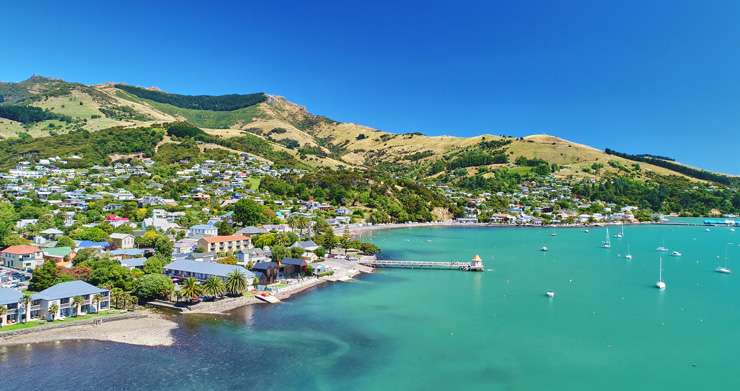
Akaroa, in Canterbury. The location has surged in value post-Covid. Photo / Getty images
While some Cantabrians do drive five hours to get to Marlborough Sounds, most like to only spend an hour or so getting to their holiday home, says Julie Graham, of Bayleys Rangiora.
Places like Motunau Beach, on the east coast just over an hour from Christchurch, are areas where boaties go: “The travel distance from Christchurch is really attractive if you’re towing a boat.”
Buyers for Motunau are usually from Christchurch or the wider Hurunui district, she says.
“They’ll come from over the hill from maybe Culverden way or somewhere like that. If they are rurally-based people but still want to be by the coast it’s not far to put your boat in – that’s what it boils down to a lot of the time.”
Also near Christchurch is French-influenced Akaroa, a town on the Banks Peninsula known for its heritage buildings.
Akaroa is largely a holiday destination, says Chris Mangels, of Bayleys, but here the baches are a bit more well-heeled with a lot of heritage cottages and also modern builds along streets with French names.
Most are owned by people from Christchurch or from mid-Canterbury but Mangels has noticed a marked increase in Aucklanders looking to buy, some with a view to relocating there permanently.
Covid put Akaroa back on the map, Mangels thinks: “People were stuck in New Zealand, weren’t they, and they travelled regionally and they realised everything they need is on the doorstep anyway.”
Change of lifestyle
Buyers are looking at permanent solutions for the future, he says. “They may be a holiday home in the short term but definitely something to spend more time at, potentially retire at. If you move to a town like Akaroa it’s got fantastic infrastructure, you can work from home easily enough and then commute into town a couple of days a week - it’s all very doable now.”
But while Aucklanders love Akaroa’s vibe, they haven’t taken over, he says. Mostly buyers are people who live an hour and 10 minutes’ drive away, including farmers from rural Canterbury.
Price-wise the transition might not be so easy either. Mangels says prices had been flat in Akaroa since the Global Financial Crisis but there was a “pretty impressive increase” post-Covid.
Down Dunedin way, people usually head inland to Queenstown Lakes and Wanaka to buy their holiday homes, says ex-All Black Kees Meeuws, from Bayleys.
“That’s the big thing different to the rest of the country. If you’re from Otago, Dunedin, Gore and everywhere like that, you head to the lakes, so you’re buying in Wanaka. They all go skiing in the winter and in the summer they are all up there on the lakes so Dunedin is like a deserted town when it comes to Christmas.”
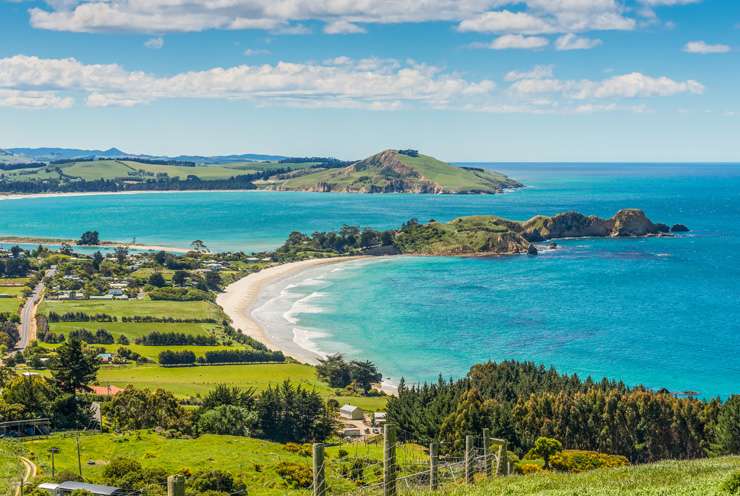
Karitane, near Dunedin, in Otago, is the go-to location for the deep south. Photo / Getty Images
While Dunedin folk go inland, inlanders go to the coast. Rhys Vidgen, from One Agency, lives in Karitane, a small settlement on the east coast about 40 minutes north of Dunedin.
People from Queenstown and Wanaka buy their second homes on the coast because they want to be able to see the sea – and it’s warmer, he says.
But even all the way down on the east coast of the South Island, Covid has had an impact. Vidgen says there has been a “reasonable spike” of out of towners looking down country. “We had a lot of people that came down from the North Island, from all over, not necessarily from places like Auckland but from places like Whanganui and Tauranga.”
The Aucklanders especially had “Covid burnout”, he says. “They just went ‘I don’t want to live like this anymore’; so a lot of people did go for change of lifestyles.”
The coast may be a long way for an Aucklander to relocate but Vidgen says if they sell up “they get to stick $500,000 in their back pockets”.
Prices along the coast and the Otago Peninsula depend on the location and the (sometimes minimal) services but there’s not much under $300,000 anymore, and there are also houses on the beach that might fetch $1.7m at Karitane.
But Covid also brought out a lot of nostalgia for what Vidgen calls “old Zealand” with cribs (what South Islanders call baches) in places like Purakanui and Long Beach popular despite limited services.
“There are a lot of properties and communities on the peninsula like that. People collect their water from the roof, they have a big tank.”
Karitane itself, an old fishing village, is more developed with mains water and sewerage, plus there’s a shop and a nice café.
Dunedin buyers like the settlement because it’s only half an hour away, which is far enough to feel like they are out of town but close enough to dash back home if they need to.
The coastline is dotted with little townships and Vidgen says newcomers are welcomed with open arms, even Aucklanders. “They hire old guys to mow their lawns and things like that. They bring revenue into these little towns and the shops love it.”















































































